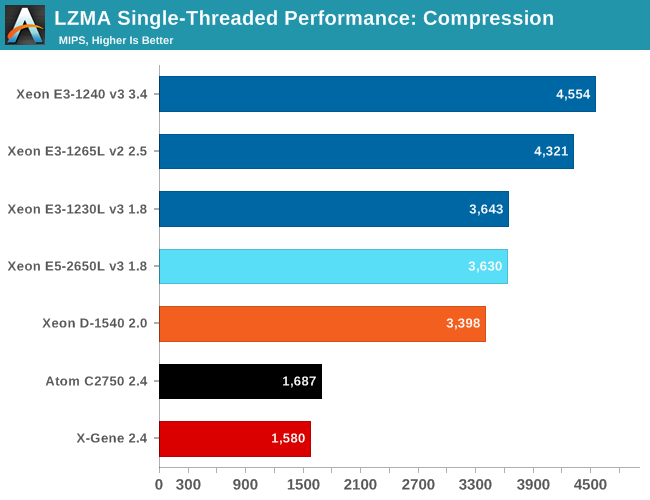The Intel Xeon D Review: Performance Per Watt Server SoC Champion?
by Johan De Gelas on June 23, 2015 8:35 AM EST- Posted in
- CPUs
- Intel
- Xeon-D
- Broadwell-DE
Single-Threaded Integer Performance
The LZMA compression benchmark only measures a part of the performance of some real-world server applications (file server, backup, etc.). The reason why we keep using this benchmark is that it allows us to isolate the "hard to extract instruction level parallelism (ILP)" and "sensitive to memory parallelism and latency" integer performance. That is the kind of integer performance you need in most server applications.
One more reason to test performance in this manner is that the 7-zip source code is available under the GNU LGPL license. That allows us to recompile the source code on every machine with the -O2 optimization with gcc 4.8.2.

The Xeon E5-2650L Haswell core is only able to boost to 2.5 GHz, while the Xeon D has a newer core (Broadwell) and is capable of 2.6 GHz. Still, the Xeon E5 is 6% faster. The most likely explanation is that the Xeon E5-2650L (65W TDP) keeps turboboost higher for a longer time than the Xeon D (45W TDP).
The Xeon D and Atom C2750 run at the same clockspeed in this single threaded task (2.6 GHz), but you can see how much difference a wide complex architecture makes. The Broadwell Core is able to run about twice as many instructions in parallel as the Silvermont core. The Haswell/Broadwell core results clearly show that well designed wide architectures remain quite capable, even in "low ILP" (Instruction Level Parallelism) code.
Let's see how the chips compare in decompression. Decompression is an even lower IPC (Instructions Per Clock) workload, as it is pretty branch intensive and depends on the latencies of the multiply and shift instructions.

The Xeon E5 runs at 2.5 GHz, the Xeon D at 2.6 GHz, the Xeon E3-1230L at 2.8 GHz, The Xeon E3-1265L can reach 3.7 GHz. The decompression results follow the same logic. There does not seem to be a difference between a Broadwell, Haswell or Ivy Bridge core: performance is almost linear with (turboboost) clockspeed. The only exception is the Xeon E3-1240 which turboboost to 3.8 GHz, but outperforms the other by a larger than expected. The explanation is pretty simple: the higher TDP (80 W) allows the chip to sustain turbo boost clock speeds for much longer.










90 Comments
View All Comments
extide - Tuesday, June 23, 2015 - link
That's ECC Registered, -- not sure if it will take that, but probably, although you dont need registered, or ECC.nils_ - Wednesday, June 24, 2015 - link
If you want transcoding, you might want to look at the Xeon E3 v4 series instead, which come with Iris Pro graphics. Should be a lot more efficient.bernstein - Thursday, June 25, 2015 - link
for using ECC UDIMMs, a cheaper option would be an i3 in a xeon e3 board.psurge - Tuesday, June 23, 2015 - link
Has Intel discussed their Xeon-D roadmap at all? I'm wondering in particular if 2x25GbE is coming, whether we can expect a SOC with higher clock-speed or more cores (at a higher TDP), and what the timeframe is for Skylake based cores.nils_ - Tuesday, June 23, 2015 - link
Is 25GbE even a standard? I've heard about 40GbE and even 56GbE (matching infiniband), but not 25.psurge - Tuesday, June 23, 2015 - link
It's supposed be a more cost effective speed upgrade to 10GbE than 40GbE (it uses a single 25Gb/s serdes lane, as used in 100GbE, vs 4 10Gb/s lanes), and IIRC is being pushed by large datacenter shops like Google and Microsoft. There's more info at http://25gethernet.org/. I'm not sure where things are in the standardization process.nils_ - Wednesday, June 24, 2015 - link
It also has an interesting property when it comes to using a breakout cable of sorts, you could connect 4 servers to 1 100GbE port (this is already possible with 40GbE which can be split into 4x10GbE).JohanAnandtech - Wednesday, June 24, 2015 - link
Considering that the Xeon D must find a home in low power high density servers, I think dual 10 Gbit will be standard for a while. Any idea what 25/40 Gbit PHY would consume? Those 10 Gbit PHYs already need 3 Watt in idle, probably around 6-8W at full speed. That is a large chunk of the power budget in a micro/scale out server.psurge - Wednesday, June 24, 2015 - link
No I don't, sorry. But, I thought SFP+ with SR optics (10GBASE-SR) was < 1W per port, and that SFP+ direct attach (10GBASE-CR) was not far behind? 10GBASE-T is a power hog...pjkenned - Tuesday, June 23, 2015 - link
Hey Johan - just re-read. A few quick thoughts:First off - great piece. You do awesome work. (This is Patrick @ ServeTheHome.com btw)
Second - one thing should probably be a bit clearer - you were not using a Xeon D-1540. It was a ES Broadwell-DE version at 2.0GHz. The shipping product has 100MHz higher clocks on both base and max turbo. I did see a 5% or so performance bump from the first ES version we tested to the shipping parts. The 2.0GHz parts are really close to shipping spec though. One both of my pre-release Xeon D and all of the post-release Xeon D systems was nearly identical.
Those will not change your conclusions but does make the actual Intel Xeon D-1540 a bit better than the one you tested. LMK if you want me to set aside some time on a full speed version on a Xeon D-1540 system for you.